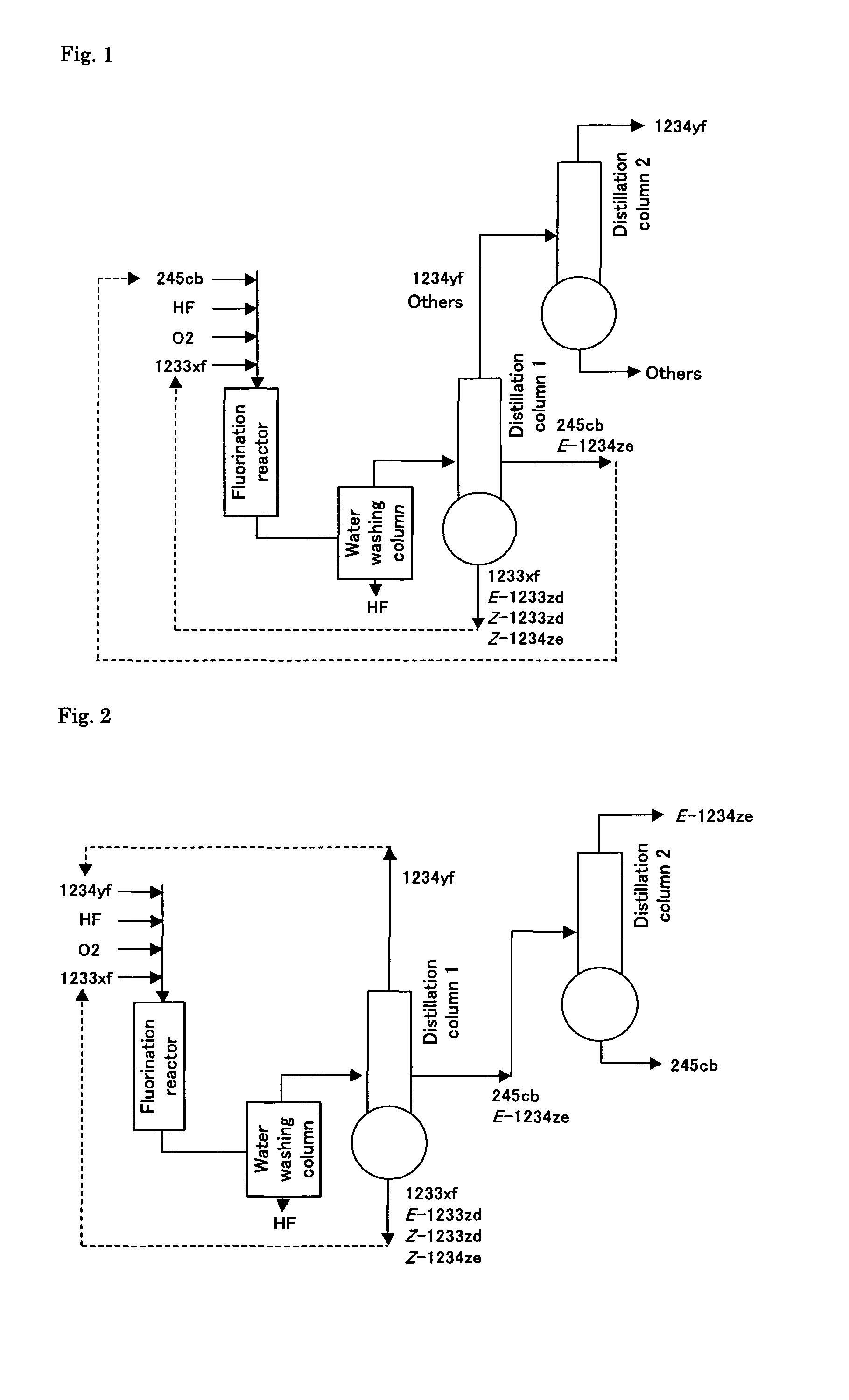Process for preparation of 2,3,3,3-tetrafluoropropene
a technology of tetrafluoropropene and tetrafluoropropene, which is applied in the field of process for producing 2, 3, 3, 3tetrafluoropropene, can solve the problems of inconvenient industrial production, ineffective industrial production method, etc., and achieves selective production and effective
- Summary
- Abstract
- Description
- Claims
- Application Information
AI Technical Summary
Benefits of technology
Problems solved by technology
Method used
Image
Examples
example 1
Production of 2,3,3,3-tetrafluoropropene
[0072]A 13.7 g amount of catalyst (fluorine content: about 15.0 wt. %) obtained by subjecting a chromium oxide represented by the composition formula CrO2.0 to fluorination treatment was placed into a tubular Hastelloy reactor having an inside diameter of 15 mm and a length of 1 m. While the reactor was maintained at atmospheric pressure (0.1 MPa) at 360° C., 76 cc / min of anhydrous hydrogen fluoride (HF) (flow rate at 0° C., 0.1 MPa) was supplied to the reactor for 1 hour, and then 2.4 cc / min of oxygen (flow rate at 0° C., 0.1 MPa) was supplied to the reactor for 0.5 hours. Thereafter, while continuing the supply of HF and oxygen, 2-chloro-3,3,3-trifluoropropene was supplied at a rate of 4.7 cc / min (flow rate at 0° C., 0.1 MPa), and the reactor temperature was changed to 365° C.; thereby a reaction was initiated. The molar ratio of HF to 2-chloro-3,3,3-trifluoropropene was 16, the oxygen amount was 50 mol % relative to 2-chloro-3,3,3-trifluoro...
example 2
[0083]The same process was carried out in the same manner as in Example 1, except that the flow rate of the oxygen was changed to 0.9 cc / min. The molar ratio of HF to 2-chloro-3,3,3-trifluoropropene was 16, the oxygen amount was 20 mol % relative to 2-chloro-3,3,3-trifluoropropene, and the contact time (W / F0) was 10 g·sec / cc. 29 hours later, the outflow from the reactor was analyzed using gas chromatography. Table 1 shows the results of the analysis.
example 3
[0084]An 8.4 g amount of catalyst (fluorine content: about 15.0 wt. %) obtained by subjecting a chromium oxide represented by the composition formula CrO2.0 to fluorination treatment was placed into a tubular Hastelloy reactor having an inside diameter of 15 mm and a length of 1 m. While the reactor was maintained at atmospheric pressure (0.1 MPa) at 345° C., 76 cc / min of anhydrous hydrogen fluoride (HF) (flow rate at 0° C., 0.1 MPa) was supplied to the reactor for 1 hour, and then 1.9 cc / min of oxygen (flow rate at 0° C., 0.1 MPa) was supplied to the reactor for 0.5 hours. Thereafter, while continuing the supply of HF and oxygen, 2-chloro-3,3,3-trifluoropropene was supplied at a rate of 9.6 cc / min (flow rate at 0° C., 0.1 MPa), and the reactor temperature was changed to 350° C.; thereby a reaction was initiated. The molar ratio of HF to 2-chloro-3,3,3-trifluoropropene was 8, the oxygen amount was 20 mol % relative to 2-chloro-3,3,3-trifluoropropene, and the contact time (W / F0) was ...
PUM
| Property | Measurement | Unit |
|---|---|---|
| pressure | aaaaa | aaaaa |
| temperature | aaaaa | aaaaa |
| density | aaaaa | aaaaa |
Abstract
Description
Claims
Application Information
 Login to View More
Login to View More - R&D
- Intellectual Property
- Life Sciences
- Materials
- Tech Scout
- Unparalleled Data Quality
- Higher Quality Content
- 60% Fewer Hallucinations
Browse by: Latest US Patents, China's latest patents, Technical Efficacy Thesaurus, Application Domain, Technology Topic, Popular Technical Reports.
© 2025 PatSnap. All rights reserved.Legal|Privacy policy|Modern Slavery Act Transparency Statement|Sitemap|About US| Contact US: help@patsnap.com

